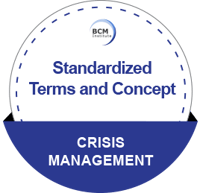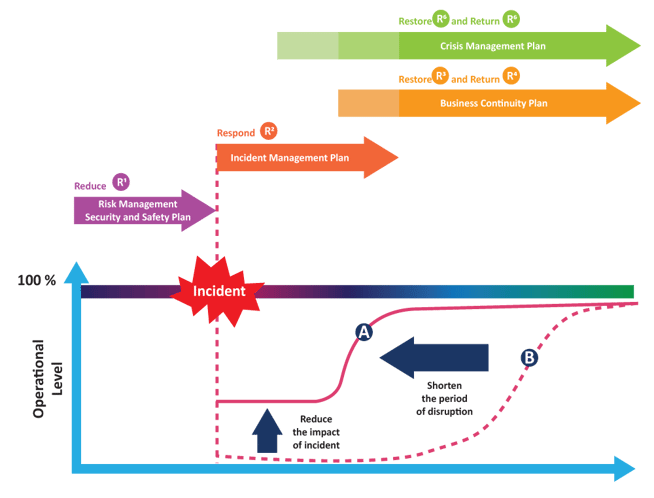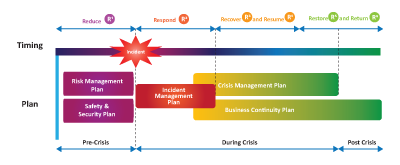CM Terminology
 Before we proceed, it is essential to understand some basic definitions used in this blog.
Before we proceed, it is essential to understand some basic definitions used in this blog.
Additional terms (BCM Institute, 2008) can be found in bcmpedia.org
 Crisis
Crisis
A crisis is a critical event that may impact an organisation's profitability, reputation, or ability to operate. It may not be time-dependent and usually does not deny access to facilities and infrastructure.
 Crisis Management (CM)
Crisis Management (CM)
Crisis Management is the overall coordination of an organisation's response to a crisis.
This is done in a practical, timely manner to avoid or minimise damage to the organization's profitability, reputation, or ability to operate.
Crisis Management Plan (CM Plan)
A CM Plan is a clearly defined and documented action plan for implementing and managing the CM process.
Crisis Management Planning (CM Planning or CMP)
CM Planning analyses vulnerabilities, evaluates existing crisis management plans and develops and implements a comprehensive CM program.
Crisis Management Team (CM Team or CMT)
CM Team consists of key executives, essential key supporting players, and the heads of business with critical functions. Each member has a set of pre-defined roles and responsibilities for implementing the CM Plan.
This team decides and approves the activation of the CM, BC or IT DR plan.

Relationship between IM, CM, and BC Plans

Relationship between IM, CM, and BC Plans and alignment to the six “Rs.”
The difference between an Emergency and a Crisis
An emergency requires immediate action to protect people, the environment or property. Examples include fires, natural disasters, or chemical spills. Emergencies are handled by “first responders”, such as fire departments and Emergency Response Teams.
A crisis (Simon, 2012) is a much broader event with a more significant impact. It may be sudden and unexpected, or it may develop over a period. A crisis is an event that, if not handled appropriately, may negatively impact the company’s profitability or reputation. Examples include significant emergencies, human resource issues, ethical issues, product safety issues, civil unrest or third-party attacks. Crisis events typically require actions by multiple departments, communications to employees and other stakeholders, and response to an event's short-term and long-term impacts.
An Emergency Response Plan addresses response-orientated issues such as life, health, safety, evacuation, floor warden, emergency, and notification. Consider it an OSHA plan required for any organization with 11 or more individuals.
Crisis management is often typically an executive-level activity (Simon, 2012), particularly in cases where the enterprise's reputation, as perceived by its marketplace and stakeholders, may be at issue. At this level, the people directly accountable for the organization can gather, weigh the issues, and make the necessary and often tough strategic and tactical decisions. The crisis is not a time for passing the buck.
CM Related Terms
These are the additional terms used for crisis management.
- Business continuity
- The organization can continue delivering products or services at acceptable predefined levels following the disruptive incident (ISO 22301, 2012).
- The organization can continue delivering products or services at acceptable predefined levels following the disruptive incident (ISO 22301, 2012).
- Business continuity management
 It is a holistic management process that identifies potential threats to an organization and the impacts on business operations those threats, if realized, might cause, and which provides a framework for building organizational resilience with the capability for an effective response that safeguards the interests of its key stakeholders, reputation, brand and value-creating activities (ISO 22301).
It is a holistic management process that identifies potential threats to an organization and the impacts on business operations those threats, if realized, might cause, and which provides a framework for building organizational resilience with the capability for an effective response that safeguards the interests of its key stakeholders, reputation, brand and value-creating activities (ISO 22301).
- Media communications management
- A proactive engagement (BS 11200, 2014) with the media to ensure that:
- Accurate information is provided;
- Coverage in the media, including social media, is monitored to assess positive and negative stories and
- The action is taken to provide accurate counterbalancing information where the organization’s reputation is damaged.
- Crisis
- The abnormal and unstable situation threatens the organization’s strategic objectives, reputation or viability.
- Crisis management
- It is developing and applying the organizational capability to deal with crises.
- It is developing and applying the organizational capability to deal with crises.
- Incident
- An adverse event that might cause disruption, loss or emergency but which does not meet the organization’s criteria for or definition of.
- An adverse event that might cause disruption, loss or emergency but which does not meet the organization’s criteria for or definition of.
- Interested party
- Person or organization that can be affected by or perceive themselves to be affected by a decision or activity (ISO 9000, 2015)3.7
- Person or organization that can be affected by or perceive themselves to be affected by a decision or activity (ISO 9000, 2015)3.7
- Risk management
- Coordinated activities to direct and control an organization concerning risk (ISO Guide 73, 2009)
- Coordinated activities to direct and control an organization concerning risk (ISO Guide 73, 2009)
- Situation report
- Summary, either verbal or written, produced by an officer or body, outlining the current state and potential development of an incident or crisis and the response to it
- Situational awareness
- State of individual and collective knowledge relating to the past and current events, their implications and potential future development
- State of individual and collective knowledge relating to the past and current events, their implications and potential future development
- Top management
- A person or group of individuals who directs and controls an organization at the highest level (ISO 9000
Difference between Crisis Management and Crisis Communications
When a crisis breaks, an organisation’s response to the situation can be divided into:
- An operational response and
- A communications response.
Consider what an organisation would do and say to bring a situation under control. Both are interrelated. What an organization does will affect what an organization can say. What an organisation says depends on what it has done or plans to do.
Crisis management manages these two responses to synchronise what an organization says and does. It starts with how an organization handles the situation operationally, which has much to do with the amount and quality of information you can muster and the robustness of the crisis managers' decision-making process. Their initial action will determine the communications response.
Crisis Communications is the management of the crisis response itself. The advice of what an organisation should or should not say, how to say it, and when is essentially the tactics of communications during crises. It is a subset of crisis management and does not necessarily help the affected company to manage the crisis strategically.
Goh, M. H. (2016). A Manager’s Guide to Implement Your Crisis Management Plan. Business Continuity Management Specialist Series (1st ed., p. 192). Singapore: GMH Pte Ltd.
Extracted from Chapter 5: Standardised Terms and Concept








![[BL-CM] [5] Register](https://no-cache.hubspot.com/cta/default/3893111/82024308-16f4-4491-98be-818a882c6286.png)

![Email to Sales Team [BCM Institute]](https://no-cache.hubspot.com/cta/default/3893111/3c53daeb-2836-4843-b0e0-645baee2ab9e.png)

![[BL-CM-3] What is a CM-300 Blended Learning?](https://no-cache.hubspot.com/cta/default/3893111/4378484c-0831-4bd5-8e68-eefd9717a50e.png)

![[BL-CM-5] What is a CM-5000 Blended Learning Course?](https://no-cache.hubspot.com/cta/default/3893111/ccefd4e5-12da-439f-b4dc-50cec862ebca.png)
![Banner [BL-5-Catalog] What Expert Level Blended Learning Courses that are Available?](https://no-cache.hubspot.com/cta/default/3893111/f39d2d89-53b2-4f11-982f-dd3462f224ac.png)
![[BL-3-Catalog] What Specialist Level Blended Learning Courses that are Available?](https://no-cache.hubspot.com/cta/default/3893111/1073197e-c1bd-47d3-97dc-32e7533619b7.png)

